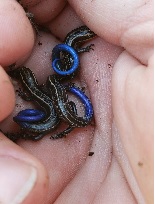Many-Lined Skink (Plestiodon multivirgatus)
Description: A moderate-sized lizard, adults average 65 mm (maximum 73 mm) snout-vent length; tail length 1.5-2.0 times body length; 23-26 scale rows around body; 53-62 dorsals; 7 (rarely 6 or 8) supralabials; postnasals usually present; 2 pairs of nuchals; usually 2 postmentals; interparietal rarely enclosed posteriorly by parietals. Dorsal ground color pale to olive brown; a light line on the third scale row bounded by narrow dark lines (sometimes reduced to dots); a pale middorsal stripe (may be lost with age); a dark line usually present on adjacent parts of first and second scale rows (may be reduced or lost in adults); lateral dark pigment present as a diffuse band or two or more dark lines, typically an upper primary and lower secondary line, the latter often edged below by a light line that follows the sixth scale row and tends to blend with the lighter venter. Lips and throat are pale, and the belly light slate. Specimens of the unstriped morph are essentially patternless, but have an indistinct dark lateral streak on head and body, darker pigment on the posterior margins of the dorsal scales, and (especially in young) an ill-defined light streak above the eye that sometimes extends over the shoulder on the third scale row. Ground color of young in both morphs is much darker than in the adult, and the tail is brilliant blue.
Habitat: Northern populations inhabit prairie grassland and sandhills; southern populations occur in creosote bush desert, streamside thickets, pinyon-juniper and pine-oak woodland, fir forests, semidesert and oak shrublands, vacant lots, dumps; soil may be rocky, sandy, or loamy. This is a secretive lizard that is usually found under ground cover.
Range: The geographic range of P. m. multivirgatus is limited in the north by southern South Dakota, Nebraska, and Wyoming and extends in the south to the Arkansas River in Colorado. P. m. multivirgatus prefers sandy soil and occurs in habitat below 5,495 feet.
P. m. epipleurotus occurs from south-eastern Utah and southern Colorado through Arizona, New Mexico, and western Texas to Chihuahua in Mexico. It lives in rocky habitat up to elevations of 8,500 feet.
Diet: Eats mainly insects
Reproduction: Oviparous. Lays 2-7 eggs, May-June; eggs attended by female, hatch in July or August. Eggs have been found under rocks.
Status: Listed as Least Concern in view of the fairly large and probably relatively stable extent of occurrence, area of occupancy, number of subpopulations, and population size. No major threats are known. Reassessment may be warranted if further taxonomic study reveals that this is a multi-species complex.
This article uses material from the Wikipedia article "Plestiodon multivirgatus", which is released under the Creative Commons Attribution-Share-Alike License 3.0. Content may have been omitted from the original, but no content has been changed or extended.
|







